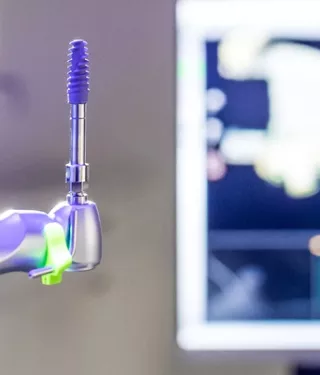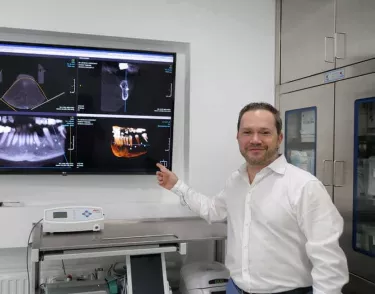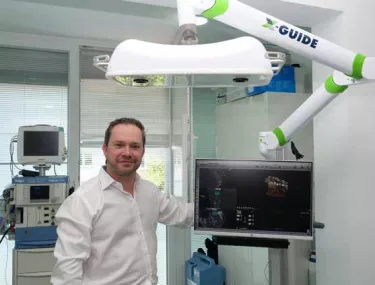
Freehand implant surgery with X-Guide™: Dr. Robert Stillmann
Dr. Robert Stillmann has been an independent dental practitioner in Austria for more than ten years and is one of the first in the country to use the dynamic navigation system, X-Guide. Here he shares his own experience with this new system.
Interview with Dr. Robert Stillmann
First full version published in Dental Journal Austria, Issue 04.19, p.22.
What was your impression of X-Guide when you first saw it at EAO in Vienna? How did it change the way you work?
Back when I was still a student, around 2003, I noticed during my oral and maxillofacial surgery internship at Vienna General Hospital with Prof. Rolf Ewers that he had a contra-angle handpiece with attached sensors for positioning. I was fascinated by it. Fifteen years later, I was really excited to discover X-Guide and see its possibilities. Until then, I performed implant treatment both freehand and with NobelGuide, using a static template in cases with low bone volume in order to have more precision than freehand, down to the very millimeter. A template also makes it easier to work with older patients if they’re on blood thinners, because the procedure itself is shorter than freehand and with less blood. In borderline cases, I would generally go back to navigated implant placement. In cases where just a millimeter’s difference could lead to failure, statically-guided implant placement with a template provides additional safety.
In all other cases, I would work freehand. That’s where dynamic navigation for implant placement with X-Guide comes into play. Here, I can combine freehand, maximum precision and predictability, which saves me time. That suits the way I work.
Can you tell us more about the way you work with X-Guide?
X-Guide gives me two great advantages compared to how I used to work. With a template, I create a virtual plan in advance and then have the template made. However, during the actual implant placement I have to work almost blindly. In the worst-case scenario, if the template slips, the implant will not sit perfectly. With X-Guide, I can detect deviations while working and correct them immediately.
The other advantage is time. I have to wait about a week for a template to be made, but with X-Guide, I can perform treatment the same day, extract the unusable tooth and place the implant with dynamic placement.
Are there any cases where you would not use it?
Personally, I don’t use it when placing multiple implants in edentulous patients. In those cases, I normally work faster with a template, but X-Guide does provide the option for edentulous navigation.
Is X-Guide an alternative for practitioners who have little experience in implant placement and avoid complicated situations?
No, you first need to be able to place the implant freehand. That is the basic requirement, just like you get your driver’s license before you drive a sports car. If you don’t have a certain number of freehand implants under your belt, it’s not a good idea to rely solely on technology.
As always, begin with minor cases, build your confidence, then work on more difficult cases. Any technology can fail, and if this happens you must still be able to complete the treatment safely, ideally, without the patient realizing. In the end, it’s the doctor who performs the surgery, not the template or the device. Not every dentist has to do implants. It might make sense to only focus on implant prosthetics and to delegate the actual placement of the implant. Unfortunately, time and time again, I see patients who are looking for implants and come to me for a second opinion because their dentist said it’s not possible. In my opinion, grinding two healthy teeth down just to avoid placing an implant, is harmful to the patient.
In addition, a single-tooth implant including an implant crown can be cheaper than a three-unit bridge in most cases. The patient has more of a financial burden with that.
Would you say that your experience with X-Guide gives you the confidence to take on more difficult cases?
Sure, definitely. In general, I’m interested in using any technology to improve my treatment outcomes and to give the patient more comfort while increasing safety.
And do patients ask you about the system? How do they react?
Yes, and very positively. During our initial consultation, I explain all the options to them. There have been cases where patients could have easily undergone implant placement without this technology, but who insist I use dynamic navigation and are willing to pay the additional costs. Those patients understand and appreciate the technical aspect.
You mentioned that not all dentists want to perform implant treatment. Do you take on such cases?
Of course. In fact, my assistant and I actually go to other dentists’ offices to perform the procedure as specialists. This helps strengthen the relationship between the dentist and the patient, because the patient sees that an additional specialist has been consulted for their individual case. All the dentist has to do is position the prosthetics with their technician, while still keeping a good portion of the contribution margin and providing optimal patient care.
Dr. Robert Stillmann provides demos of X-Guide in Austria. For demos in your area, contact us today.

